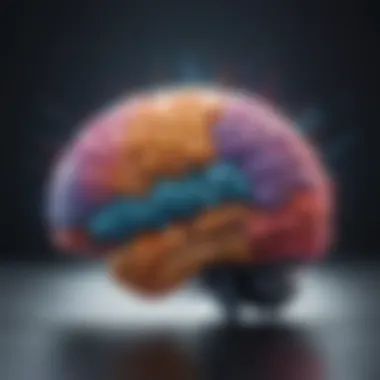Exploring the Purpose and Significance of Dreams


Intro
Dreams have captivated human beings for centuries. The enigmatic nature of dreams invites curiosity and speculation. While we often experience dreams during sleep, their significance extends far beyond mere fantasy. This article seeks to unravel the complexities associated with dreaming. The aim is to provide a nuanced understanding of why we dream, based on a combination of historical insights and contemporary research.
Key Research Findings
Overview of Recent Discoveries
Recent studies have revealed much about the potential functions of dreams. Notably, researchers have identified that dreaming may play a crucial role in emotional regulation and problem-solving. Various methods in neuroscience, such as brain imaging, have been employed to observe brain activity during REM sleep, where most vivid dreams occur. These findings have initiated robust discussions around the therapeutic potentials of dreams in mental health practices.
Significance of Findings in the Field
The implications of these findings are profound. Understanding the psychological aspects of dreaming can offer tools for educators and therapists. For instance:
- Emotional Processing: Dreams often reflect unresolved feelings or experiences, allowing individuals to process emotions.
- Creativity: Some researchers propose that dreams foster creativity by allowing free association, unrelated to conscious constraints.
- Memory Consolidation: Sleep researchers argue that dreams play a part in consolidating memories, thereby improving learning outcomes.
These aspects are particularly relevant for students and professionals aiming to enhance their cognitive functions.
Breakdown of Concepts
Simplification of Advanced Theories
Several theories attempt to explain why we dream. These range from psychological to physiological perspectives. Some prominent theories include:
- Freudian Theory: Sigmund Freud suggested that dreams are the expression of repressed desires. According to him, exploring dreams could reveal inner conflicts.
- Activation-Synthesis Theory: Proposed by researchers Allan Hobson and Robert McCarley, this theory posits that dreams are the brain's attempt to make sense of random neurological activity during sleep.
- Information Processing Theory: Suggests that dreams help in sorting and processing the vast amount of information heroes encounter daily.
Each of these theories contributes to our understanding of the dreaming process, although they may differ in focus and conclusions.
Visual Aids and Infographics
To further illustrate these theories and findings, visual aids can enhance comprehension. Infographics detailing brain activity during sleep cycles or charts representing the stages of sleep can be particularly useful. Such visuals can serve as effective tools to communicate complex ideas more clearly, benefiting educators and students alike.
Indepth understanding not only informs individual practices but can also influence broader institutional strategies in the realms of education and mental health.
"Dreams are the royal road to the unconscious." - Sigmund Freud
Intro to Dreams
Understanding dreams is essential for grasping their significance in human experience. This section will provide foundational insights into what dreams are and why they hold such value across cultures and disciplines.
Defining Dreams
Dreams can be defined as a series of thoughts, images, or emotions occurring during sleep. They often reflect the subconscious mind and can draw upon emotions, memories, and perceptions from waking life. The content of dreams can range from the mundane to the extraordinary, each carrying potential insights into the dreamer’s psyche. Psychologists and neuroscientists explore dreams to better understand the workings of the human brain.
Dreams occur in different stages of sleep, predominantly during Rapid Eye Movement (REM) sleep. This stage is crucial as it contributes substantially to memory consolidation and emotional processing. Recent studies indicate that dreams may contribute to learning and problem-solving. The complexities of dreams make defining them challenging, given their subjective nature; what one person dreams about may differ greatly from another, underscoring their personal significance.
The Universality of Dreaming
Dreaming is a universal human experience. Regardless of culture or geography, nearly all individuals report having dreams. From ancient civilizations to contemporary societies, dreams have been a source of fascination and investigation. Various cultures interpret dreams as prophecies, unresolved conflicts, or reflections of the dreamer’s emotional state.
The significance of dreams extends beyond individual interpretation. They can serve as a medium for cultural narratives and collective consciousness. Many people turn to their dreams for guidance, insight, or even inspiration. As we delve deeper into the realm of dreams, it is crucial to note their influence on art, religion, and mythology in numerous societies. This cross-cultural exploration emphasizes that dreams not only hold significance on an individual level but can also influence societal beliefs and practices.
Histories of Dream Interpretation
Exploring the histories of dream interpretation reveals how deeply intertwined dreams are with human culture and society. This section highlights various perspectives through time that offer valuable insights into how people understood their dreams. This understanding is essential because it sets the stage for modern interpretations and acknowledges the rich tapestry of thought surrounding the phenomenon of dreaming.


Ancient Cultures and Dreams
Throughout ancient times, dreams were often seen as messages from the divine or as portals to other realms. Civilizations like the Egyptians and Greeks attributed much significance to dreams.
- Egyptians often interpreted dreams as omens, which guided daily life and major decisions. They documented these interpretations in texts like the "Dream Book of Amasis."
- Greeks, particularly philosophers like Aristotle and Plato, examined dreams through a more philosophical lens. They debated whether dreams held prophetic power or were simply reflections of everyday thoughts and fears.
In many ancient cultures, dreams offered a connection to the spiritual world, serving purposes beyond mere subconscious activity. They were considered as a way to commune with ancestors or deities, thus granting them a critical role in societal rituals and governance.
Medieval Perspectives
During the medieval period, the understanding of dreams evolved significantly. With the rise of Christianity, there was a shift towards viewing dreams primarily through a theological perspective. Dreams were frequently seen as tools for spiritual guidance or warnings from God.
- Many church leaders compiled dream manuals for interpretation, aiming to educate believers on their possible meanings.
- Notable figures like St. Augustine and Thomas Aquinas incorporated their theological views into dream analysis, suggesting that not all dreams should be trusted. The belief that dreams could result from malice or deceit by evil forces emerged during this era.
As a result, medieval perspectives cemented the religious significance of dreams while introducing skepticism regarding their origin and truthfulness.
Freudian and Jungian Theories
The late 19th and early 20th centuries marked a pivotal moment in dream interpretation, largely through the work of Sigmund Freud and Carl Jung.
- Freud proposed that dreams were a window into the unconscious, serving as expressions of repressed desires and unresolved conflicts. His book, The Interpretation of Dreams, posited that analyzing dreams could unlock hidden wishes. Freud’s emphasis on sexuality and childhood experiences sparked extensive debate.
- In contrast, Carl Jung introduced a more expansive view. He believed that dreams were not only personal but also collective, intertwining individual experiences with universal archetypes. Jung emphasized symbols and themes that could indicate broader, shared experiences across cultures.
These theories from Freud and Jung remain influential in psychology today, offering frameworks for understanding the complexity and meaning of dreams.
Understanding the evolution of dream interpretation over centuries allows for a richer perspective on how these nocturnal experiences shape our thoughts and beliefs.
Modern Psychological Theories
Modern psychological theories provide crucial insights into the intricate processes underlying dreaming. By examining contemporary perspectives on dreams, we can grasp how they influence our mental states and daily lives. Understanding these theories helps students, researchers, and professionals deepen their grasp of psychology and neuroscience. This section highlights cognitive processes, emotional regulation, and problem-solving related to dreams.
Cognitive Processes and Dreams
Cognitive processes play a significant role in how we experience dreams. During sleep, the brain remains active, engaging in complex activities such as memory consolidation and information processing. Researchers propose that dreams serve as a way to organize and integrate experiences, allowing the brain to work through unresolved issues or emotions.
"Dreaming may reflect the brain's effort to synthesize and adapt new information."
In this sense, dreams become possible indicators of our cognitive health. They reveal how effectively we manage stress, learn from experiences, and adapt to changes in our environment. Studies show that analyzing dream content can provide valuable insights into cognitive function, potentially influencing therapeutic approaches.
Emotional Regulation through Dreaming
Another key aspect of modern psychological theories is the concept of emotional regulation during dreaming. Dreams often reflect emotions we may struggle to express or process while awake. They offer a unique context for confronting fears, anxieties, and unresolved conflicts. Through these nocturnal narratives, individuals can explore feelings in a safe environment, ultimately aiding emotional well-being.
Research indicates that dreams can help minimize negative emotions and promote resilience. By processing emotions within dreams, one can experience catharsis, assisting in coping mechanisms for challenges encountered in waking life. Thus, understanding the emotional aspects of dreams is essential for improving mental health strategies.
Problem Solving in Dreams
The notion of problem solving in dreams is a fascinating area of study. Many people report experiencing solutions to problems or creative ideas during sleep. Modern psychological theories suggest that the sleeping mind approaches challenges differently than the awake mind. This different approach can lead to spontaneous insights and innovative solutions.
The brain, in a dream state, tends to make unique associations that may not be obvious during conscious thought. As such, prioritizing dream analysis can open avenues for creativity and intellectual growth. Encouraging individuals to reflect on their dreams can enhance both personal and professional problem-solving capabilities.
In summary, modern psychological theories reveal the multifaceted role of dreams in cognitive processes, emotional regulation, and problem-solving. Recognizing these critical aspects enhances our understanding of the potential benefits of dreaming on our overall mental health and creative pursuits.
Neuroscience of Dreams
The neuroscience of dreams is a critical area of study within the broader context of understanding dreams. This section investigates how the brain functions during dreaming, placing emphasis on physiological processes. It contributes to our comprehension of the significance of dreams by linking neurological mechanisms to the experience of dreaming itself. By delving into this topic, students and researchers can gain insight into how different brain structures and activities shape dream content and frequency.
Physiological Bases of Dreaming


Dreaming primarily occurs during sleep, specifically during the phase known as REM sleep, but other stages also contribute to dream experiences. Physiologically, dreaming can be understood through several aspects:
- Brain Activity: During REM sleep, there is heightened activity in the brain, particularly in areas related to emotions and imagination such as the amygdala and the visual association areas. This contributes to vivid imagery commonly seen in dreams.
- Neurotransmitters: Neurotransmitters like acetylcholine and serotonin play vital roles in regulating sleep and dreaming. These substances influence the transitions between sleep stages, impacting the overall experience of dreams.
- Memory Processing: The brain also engages in memory consolidation during sleep. Dreams may reflect a person's memories and experiences, processing these elements in a non-linear fashion.
Understanding these physiological bases helps elucidate why we dream, providing a scientific grounding for the function of dreams in our lives.
The Role of REM Sleep
Rapid Eye Movement (REM) sleep is fundamental to the dream process. This stage of sleep is characterized by several distinct features that are crucial for dream occurrences:
- Vivid Dreaming: REM is when most vivid dreams happen. The brain is highly active, resembling its activity when awake. This is when dreams can feel real and impactful.
- Physiological Changes: REM sleep involves specific physiological changes such as increased heart rate and breathing patterns, which can also influence the emotional content of dreams.
- Cognitive Functions: Research indicates that REM sleep plays an essential role in cognitive functions such as learning and problem solving. The insights gained through dreams during this stage can sometimes influence a person's thoughts and creativity during waking life.
"Dreaming offers a fascinating window into the complexity of the human mind and its processes, revealing much about emotional and cognitive states."
The interplay between REM sleep and dreaming is essential for appreciating the broader implications of dream analysis in both psychological and neuroscientific contexts. Recognizing these relationships is vital for researchers seeking to explore the depth of dreams and their significance in human experience.
Types of Dreams
The study of dreams offers a lens through which we can examine the variety of experiences that occur during sleep. Understanding the types of dreams can provide insights into our subconscious minds, emotional states, and cognitive processes. Each type of dream serves a distinct purpose and can aid individuals in navigating their thoughts and feelings. This section focuses on three prominent types of dreams: lucid dreams, nightmares, and recurring dreams. Each type holds significance in dream research and psychological exploration.
Lucid Dreams
Lucid dreaming occurs when the dreamer becomes aware that they are dreaming. This awareness often allows for a degree of control over the dream narrative. The significance of lucid dreams lies in their potential for personal exploration and problem-solving. Many individuals use lucid dreaming as a tool for creativity, enabling them to experiment with ideas without the constraints of reality. This type of dream can also be beneficial for therapeutic purposes, helping individuals confront fears or traumatic memories in a safe environment.
Lucid dreams can enhance self-awareness and provide an avenue for individuals to explore their desires and anxieties. Techniques such as reality testing and keeping dream journals can facilitate the experience of lucid dreaming. Furthermore, studies suggest a potential correlation between lucid dreaming and improved emotional regulation, underscoring its relevance in psychological research.
Nightmares
Nightmares are distressing dreams that can provoke feelings of fear, anxiety, or insecurity. Often linked to stress or trauma, nightmares can have a profound impact on an individual's overall well-being. Understanding nightmares is crucial as they may reveal unresolved conflicts or traumas lurking in one's subconscious. Many people experience nightmares at some point in their lives, and for some, they become recurrent.
The implications of nightmares extend beyond mere discomfort. Research indicates that they can disrupt sleep patterns, leading to a decline in health and productivity. Therapeutic interventions such as imagery rehearsal and cognitive behavioral techniques can aid those troubled by frequent nightmares. By addressing the root causes, individuals may find relief from the emotional turmoil that nightmares can cause.
Recurring Dreams
Recurring dreams present as repetitive themes or narratives that often hold significant meaning for the dreamer. These dreams frequently occur during periods of stress or transition in one's life, serving as a reflection of unresolved issues or fears. Recognizing the content of recurring dreams can facilitate greater self-understanding and personal growth.
Recurring dreams may manifest in various forms, sometimes revealing patterns of behavior or emotional struggles that require attention. Additionally, they can present opportunities for closure or resolution. Engaging with the themes of these dreams through reflection or therapy can pave the way for transformative change in waking life. Analyzing these repetitions can provide valuable insights and guide individuals toward addressing their underlying concerns.
Cultural Significance of Dreams
In examining the significance of dreams, it is vital to understand their cultural implications. Dreams are not merely a personal experience; they hold a place in the collective psyche of societies. Across various cultures, dreams serve as a bridge between the conscious and the unconscious, often carrying symbolic meanings that reflect the values and beliefs of a group.
Dreams in Literature and Art
Dreams have long inspired writers, artists, and thinkers. In literature, works like "Alice's Adventures in Wonderland" by Lewis Carroll exemplify how dreams can craft surreal narratives. Carroll's dreamlike world relies on the fluidity of time and identity, emphasizing how dreams allow exploration beyond reality's confines. Similarly, many poets draw from dream imagery to evoke emotions and abstract ideas. Literature that incorporates dreams often reflects the author's inner conflicts and subconscious thoughts, providing deeper commentary on the human experience.
In visual arts, dream representations can be found in the works of Salvador Dalí, whose paintings evoke the irrational and bizarre quality of dreaming. Artists utilize dream themes to challenge perceptions and provoke thoughts about existence and the subconscious mind. The cultural significance of dreams in art is not merely aesthetic but also intellectual—prompting discussions on perception and reality, thus enriching cultural narratives.
Spiritual and Religious Perspectives
Across many cultures, dreams hold spiritual and religious significance. In many Indigenous cultures, dreams are considered a means of communication with the spirit world. They may offer guidance, prophecies, or warnings, deeply intertwining with cultural identity and practices. For example, certain Native American tribes regard dreams as sacred, guiding individuals on their life paths or during initiations.
Similarly, in Christianity, biblical accounts illustrate dreams as divine messages. Examples such as Joseph's dream about the future of his family show how dreams can influence crucial life decisions and historical events. In Islamic tradition, dreams are seen as avenues for divine revelation, where many believers seek interpretations from scholars or religious guides.
"Dreams are the royal road to the unconscious." – Sigmund Freud
This relationship between dreams and spirituality reaffirms the transcendent role that dreaming plays in human cultures. Understanding dreams within these contexts underscores their importance beyond mere psychological phenomena, prompting individuals to explore deeper meanings in their experiences.


In summary, the cultural significance of dreams spans literature and spirituality, serving as a rich source of insight and interpretation. Their impact transcends individual experience, influencing collective beliefs and artistic expression, thereby shaping how societies understand the human condition.
Practical Implications of Dream Analysis
The exploration of dreams carries far-reaching implications, particularly regarding practical applications in various fields. Understanding dreams can help individuals manage their emotional landscape and foster self-awareness. Dream analysis offers pathways to personal insights and emotional growth.
Therapeutic Uses of Dreamwork
Dreamwork, a therapeutic technique that uses dreams for insight, has become increasingly recognized in psychology. Therapists often encourage patients to recall dreams as part of the therapeutic process. This practice can help unpack emotions and subconscious thoughts.
- Dreams reveal suppressed feelings. They can highlight unresolved issues.
- Techniques such as journaling dreams can improve memory and understanding of emotions.
- Talking about dreams in therapy creates a space for dialogue about the unconscious.
This method allows for deeper emotional connection. For example, Carl Jung advocated for dream analysis to explore the collective unconscious. Jung believed that dreams could bridge the gap between conscious awareness and unconscious desires. By validating personal experiences, dreamwork can enhance therapeutic effectiveness.
Enhancing Creativity through Dreams
Beyond the therapeutic landscape, dreams have significant implications for creativity. Many artists and researchers have reported that their ideas were inspired by dreaming. The unfiltered nature of dreams can provide a fresh perspective and unlock creative potential.
- Many well-known figures, such as Salvador Dalí, used dream symbolism in their work.
- Dreams allow for free association of ideas, helping to overcome mental blocks.
- Engaging with dreams can lead to innovative solutions to problems that seem insurmountable during waking hours.
This creative aspect stems from the brain's activity during REM sleep. In this state, the brain combines information in novel ways. This process can lead to breakthroughs in artistic expression, scientific research, or personal projects.
Understanding the practical implications of dreams opens numerous avenues for both therapeutic and creative development. As more individuals and professionals take an interest in dream analysis, the benefits are likely to continue growing.
"Dreams are the royal road to the unconscious." - Sigmund Freud
Future Directions in Dream Research
The exploration of dreams continues to evolve, revealing significant insights into human cognition and emotion. Understanding future directions in dream research is essential for deepening our comprehension of this complex subject. Potential advancements may not only provide clarity on existing theories but also uncover novel interpretations that can enrich psychological and neurological studies. Moreover, an investigation into future research trajectories highlights the importance of interdisciplinary collaboration across the fields of psychology, neuroscience, and technology.
Emerging Technologies in Dream Study
Recent advancements in technology have paved the way for groundbreaking methods of studying dreams. Techniques such as functional magnetic resonance imaging (fMRI) and electroencephalogram (EEG) provide detailed insights into the brain's activity during sleep cycles. These technologies facilitate the mapping of brain patterns associated with specific types of dreams. Researchers can now observe how emotional responses and memories are processed during dreaming.
- Neuroscientific Tools: New imaging technologies allow scientists to visualize brain activity related to dreaming. Understanding the neural correlates of dreams can elucidate their psychological significance.
- Sleep Monitoring Devices: Wearable devices help track sleep stages, giving researchers critical data on sleep patterns and dream occurrences. Through this data, patterns can be identified that correlate with emotional states and cognitive processing.
This technological progress is vital as it opens avenues for empirical research that can either confirm or challenge existing theories about the purpose of dreams. It provides tools for a more scientific approach to dream interpretation, enhancing the credibility and societal understanding of dreams.
Potential Breakthroughs in Understanding Dreams
The integration of emerging technologies in dream research heralds a new era of possibilities. Potential breakthroughs may shift current paradigms surrounding the psychology of dreams. By combining new findings from both neuroscience and psychological studies, researchers can formulate more comprehensive theories.
- Enhanced Understanding of REM Sleep: As more is learned about the role of REM sleep, researchers can better assess the impact of this phase on creativity and emotional healing. This could lead to novel therapeutic methods for mental health.
- Linking Dreams and Consciousness: Exploring how dreaming relates to conscious thought processes can clarify the relationship between the two states. These breakthroughs can redefine psychological practices and enhance therapeutic strategies.
The quest for understanding dreams is not merely academic. A more profound comprehension of dream processes can lead to effective therapeutic applications. As research progresses, society may benefit from improved coping strategies for various emotional and psychological issues, enhancing overall well-being.
"Emerging technologies facilitate a deeper exploration of dreams, revealing the intricate ties between our unconscious thoughts and waking lives."
Through continued investment in dream research, we embark on a journey toward unraveling some of the most profound mysteries of human experience. By looking forward, we can pave the way for a future enriched with respect for the complexities of our nighttime adventures.
Ending
Understanding dreams is not just an intellectual pursuit; it impacts many facets of psychological health and cognitive functioning. This article emphasizes the significance of dreams as windows into our subconscious, functioning not only as reflections of our daily lives but also as vital tools for emotional regulation and problem-solving. The exploration of dreams benefits the fields of psychology, neuroscience, and even creativity.
Recap of Key Points
The central themes of this exploration include:
- Dreams are universal experiences that occur across cultures and epochs.
- The historical context ranging from ancient interpretations to Freudian theories and beyond provides a foundation for modern understandings.
- Contemporary psychological theories shed light on the cognitive processes behind dreaming.
- The physiological mechanisms, particularly REM sleep, underscore the neurological relevance of dreams.
- There are various types of dreams, such as lucid dreams, nightmares, and recurring dreams, each serving unique functions in our lives.
- Cultural significance is evident in the way dreams influence literature and art, reflecting human thought and emotion.
- Practical applications include therapeutic uses of dreamwork and the enhancement of creativity.
The Enduring Mystery of Dreams
Despite all the research, the essence of why we dream remains a topic of fascination. Many questions linger about the purpose and function of dreams. While theories abound, a certain degree of enigma persists. This enduring mystery invites both scientific inquiry and personal introspection, prompting individuals to reflect on the deeper meanings of their dreams. They are not merely random images; they can be profound insights into our conscious and unconscious minds.















